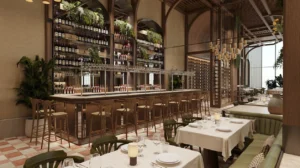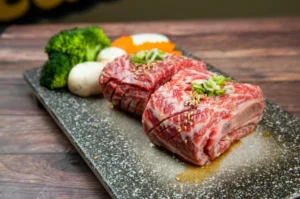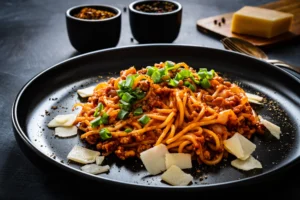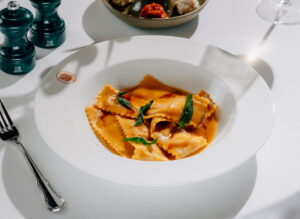At MamaBella, our approach to Italian cooking is simple and time-honored: follow the seasons and let the market lead the menu. From the hills of Barbagia to the shores of Cagliari, Sardinian tradition celebrates ingredients at their peak—an ethos we proudly bring to Dubai at Kempinski, The Boulevard. As we prepare for our opening, this month-by-month guide showcases how seasonal fruits, vegetables, herbs, and coastal specialties inspire our handcrafted pasta and wood-fired pizza program. It’s a practical companion for anyone seeking authentic Sardinian cuisine in Dubai, and a preview of the flavors you’ll soon find on our menu.
Key takeaways:
- Cooking with seasonal ingredients enhances flavor, supports local producers, and aligns with sustainable Mediterranean practices.
- Each month offers signature produce—from winter citrus and roots to summer tomatoes and basil—that naturally guides recipe pairings.
- MamaBella’s Sardinian heritage informs every choice, from semolina pasta shapes to wood-fired techniques and market-fresh seafood.
Why seasonal ingredients matter in Sardinian cuisine
In Sardinia, the calendar is the first ingredient. When produce is harvested at its peak, it delivers sweetness, acidity, and aroma that don’t need heavy embellishment. That’s why our culinary team focuses on proximity and ripeness—tomatoes with sun-warmed skins, artichokes with tight leaves, herbs clipped the same morning. Freshness reduces transport time, preserves nutrients, and heightens flavor, all while supporting growers whose craft sustains the Mediterranean landscape. For guests exploring an Italian restaurant in Dubai with deep regional roots, that fidelity to seasonality is what makes a plate of pasta taste unmistakably “of the moment.”
How seasonal cooking elevates flavor
Seasonality is more than availability—it’s synergy. Ingredients harvested together often harmonize naturally: spring peas and young onions, summer tomatoes and basil, autumn squash with sage. We build dishes around those pairings, then select cooking methods to amplify them: quick sautés for delicate greens, slow roasts for dense roots, and blistering wood-fire for vegetables that love char and smoke. The result is cuisine that is lighter in summer, comforting in winter, and always true to Sardinian sensibilities—simple techniques, premium ingredients, and family-style generosity.
Seasonal ingredients in Italian cooking: a month-by-month guide
Below, you’ll find a culinary calendar that inspires our R&D and menu planning at Kempinski. Because MamaBella is currently in a pre-launch phase in Dubai, treat this as a delicious roadmap rather than a fixed roster—our chefs will adapt to the best arrivals at market each week.
January: Root vegetables & citrus
January’s cool air sharpens flavors. We lean into carrots, beets, turnips, and bright oranges or lemons. A roasted beet and carrot salad with citrus vinaigrette is equal parts earthy and zingy, while a lemon-zest butter gently perfumes handmade tagliatelle. For something heartier, char red onions in the wood-fired oven and fold them into a saffron-tinged barley soup—a nod to Sardinia’s love of grains.
February: Brassicas & winter greens
Kale, cavolo nero, and broccoli thrive now. A winter greens lasagna layers ricotta, sautéed cavolo nero, and mozzarella for comfort without heaviness. Broccoli florets caramelize beautifully under wood-fire heat, then meet garlic and chili in a rustic side. These vegetables are nutrient-dense, sturdy, and perfect for slow evenings with family.
March: Asparagus & artichokes
Spring’s first signs arrive as asparagus spears and globe artichokes. We love grilled asparagus on pizza with ricotta and a drizzle of balsamic; the heat gives sweet, smoky edges that play well with mellow cheese. For pasta, tender artichoke hearts are sautéed with garlic and parsley, tossed with linguine, and finished with pecorino—clean, elegant, unmistakably Mediterranean.
April: Peas & spring onions
Young peas and spring onions are sweet and delicate. A classic risotto begins with soft-sweated onions and toasted Arborio, then broth, then a tumble of peas added late to keep their color and snap. Finish with grated pecorino and a thread of extra virgin olive oil. This is Sardinia’s love of simplicity on a spoon.
May: Strawberries & fresh herbs
May invites herbs—basil, mint, parsley—and early strawberries. For dessert, macerate strawberries with a whisper of balsamic and basil. On the savory side, spaghetti al limone gets a green lift from torn mint and parsley. Menus in May feel light, fragrant, and picnic-friendly, ushering in summer’s abundance.
June: Zucchini & tomatoes
With heat rising in Dubai, we keep preparations brisk. Raw shaved zucchini and cherry tomatoes with lemon and olive oil make a bright contorno. For something rustic, a Sardinian-style ciambotta (a Mediterranean cousin to ratatouille) stews zucchini, tomatoes, onions, and peppers slowly until spoon-tender. Tomatoes also become the soul of our sauces—think San Marzano, basil, garlic, and patience.
July: Summer fruits & basil
Stone fruits, berries, and basil lead the way. A basil pesto can be brightened with diced peach for a sunny, savory-sweet spin—tossed through chilled fregola for a summer salad. For the grill, halved nectarines get a quick kiss of heat before meeting creamy burrata and a scatter of toasted almonds. It’s peak season on a plate.
August: Eggplant & bell peppers
Eggplant and peppers love fire. We roast slices to concentrate sweetness, then layer them onto pizza with tomato, mozzarella, and ricotta. A final spoon of basil oil ties it to the garden. Caponata—Sicily’s gift often embraced in Sardinia too—translates beautifully with local peppers, raisins, and pine nuts for sweet-sour balance. The wood-fired oven gives everything a satisfying char.
September: Grapes & figs
Early autumn is generous. Grapes and figs bring honeyed notes to savory dishes: pair grilled figs with prosciutto and peppery greens, or bake a fig-grape crostata finished with thyme. In salads, figs add plush texture beside walnuts and young pecorino. These fruits also complement roast meats and aged cheeses in family-style spreads.
October: Pumpkins & chestnuts
We turn to silkier textures and toasted aromas. Pumpkin purée becomes the filling for culurgiones—Sardinia’s iconic hand-pleated pasta—enriched with pecorino and hint of nutmeg. A brown-butter-and-sage sauce echoes the nuttiness, while roasted chestnuts add sweetness and snap. Serve alongside a tangle of wild greens dressed simply.
November: Squash & wild mushrooms
When evenings cool, roasted butternut soup with sautéed leeks and nutmeg is soothing and refined. A wild mushroom risotto, patiently stirred with vegetable broth, allows porcini and friends to shine without distraction. Finish with parsley and Parmigiano-Reggiano. This is the month for lingering at the table and sharing bowls from the center—our preferred way to dine.
December: Cabbage & nuts
Winter brassicas are sweet after a chill. Finely shredded cabbage tossed with apples, toasted walnuts, and a light vinaigrette brightens rich main courses. For pasta, think malloreddus (Sardinian semolina gnocchi) with savoy cabbage, garlic, and a touch of cream for comfort. Pomegranate seeds add sparkle to salads and dessert garnishes alike.
Signature Sardinian dishes that celebrate the seasons
Seasonality guides our iconic preparations year-round. Four favorites reflect the island’s pantry and our technique:
- Culurgiones: Pleated pasta parcels traditionally filled with potato, mint, and pecorino. We adapt fillings to the calendar—spring herbs in April, pumpkin in October—always finished simply so the dough and cheese sing.
- Porceddu: A celebratory roast known for its aromatics—myrtle, rosemary, and sea salt. Seasonal sides matter: bitter greens in winter, grilled vegetables in summer. The result is deeply Sardinian.
- Fregola con arselle: Toasted semolina pearls with clams, tomato, garlic, and parsley. Summer’s sweet tomatoes and autumn’s herbs make the broth especially memorable.
- Pane carasau: Paper-thin crispbread baked twice for crackle, perfect with seasonal cheeses, olive oil, or softly braised vegetables.
What to expect at MamaBella (pre-launch at Kempinski, The Boulevard)
MamaBella is crafting a premium, family-centered dining experience that blends rustic Sardinian charm with Dubai’s modern elegance. Picture sun-lit rooms, natural textures, and the scent of olive wood from the pizza oven. Our culinary team is finalizing a menu that foregrounds handcrafted pasta made daily, wood-fired pizzas with blistered crusts, and traditional antipasti that showcase Mediterranean ingredients. Because we are in a pre-launch phase, offerings will evolve with peak seasonal availability and market finds—exact dishes may vary, but the philosophy will not.
Plan your visit and explore more
Curious about dishes you’ve read here? Browse our menu for the latest concepts, learn about our Sardinian roots at our Sardinian restaurant in Dubai, or secure a special occasion with a simple click via reserve your table. If you’re dreaming of velvety sauces and al dente ribbons, discover where to find the best handcrafted pasta in Dubai, and when char-kissed crust calls your name, explore our take on wood-fired pizza in Dubai. These pages will be updated as we move closer to welcoming you.
Frequently asked questions
What are the benefits of using seasonal ingredients in Italian cooking?
Seasonal ingredients deliver superior flavor, nutrition, and texture at peak ripeness. They also support regional producers and reduce transport, which aligns with Mediterranean sustainability. For guests seeking Sardinian cuisine in Dubai, seasonality ensures every plate tastes vibrant and immediate.
How does MamaBella incorporate seasonal produce?
Our chefs design around the calendar, then refine dishes based on what’s freshest at market each week—artichokes in March, peas in April, tomatoes and basil through high summer, and chestnuts by October. That rhythm keeps the experience dynamic while honoring tradition.
Can you share examples of seasonal pairings?
Absolutely: asparagus and ricotta on wood-fired pizza in March; pea-and-spring onion risotto in April; caponata-style eggplant and peppers in August; pumpkin-and-sage pasta in October; wild mushroom risotto in November; and citrus-bright salads in January.
Why follow a month-by-month guide?
A monthly framework helps home cooks and professionals plan menus that taste right for the season and minimize waste. It also encourages variety—no two months feel the same—so diners experience a living expression of Sardinia at the table.
Where can I learn more or plan a meal?
Start with our Italian restaurant in Dubai overview, then dip into the menu. When you’re ready to celebrate, reserve your table and let the season decide your favorites.






